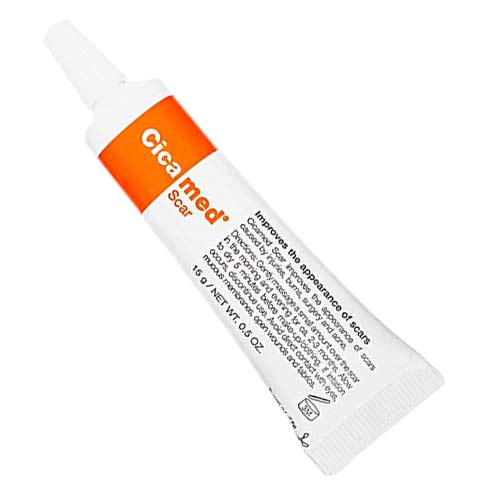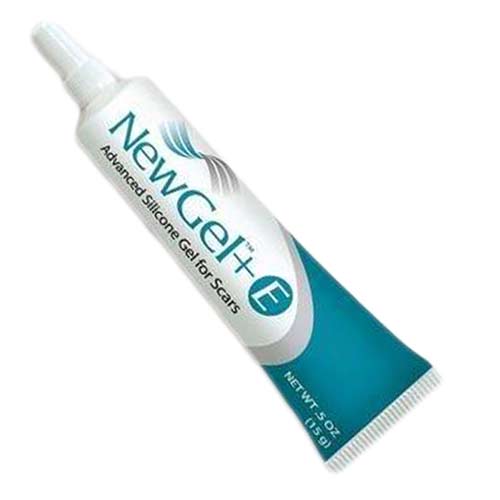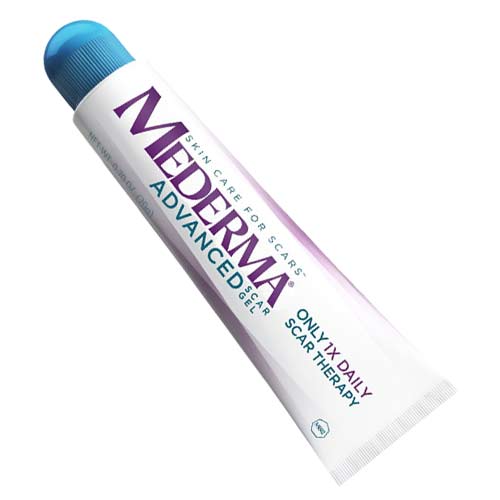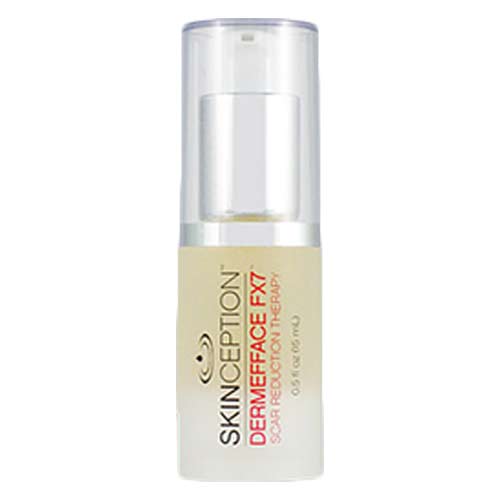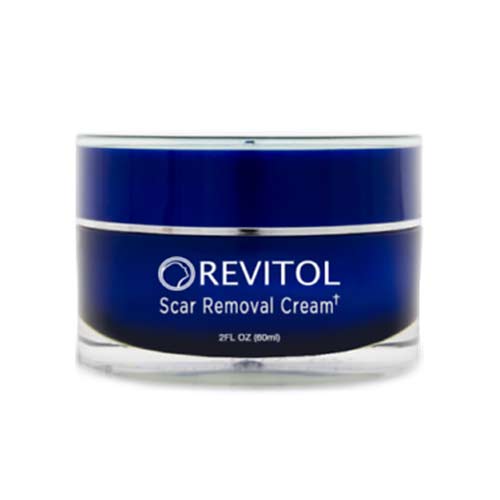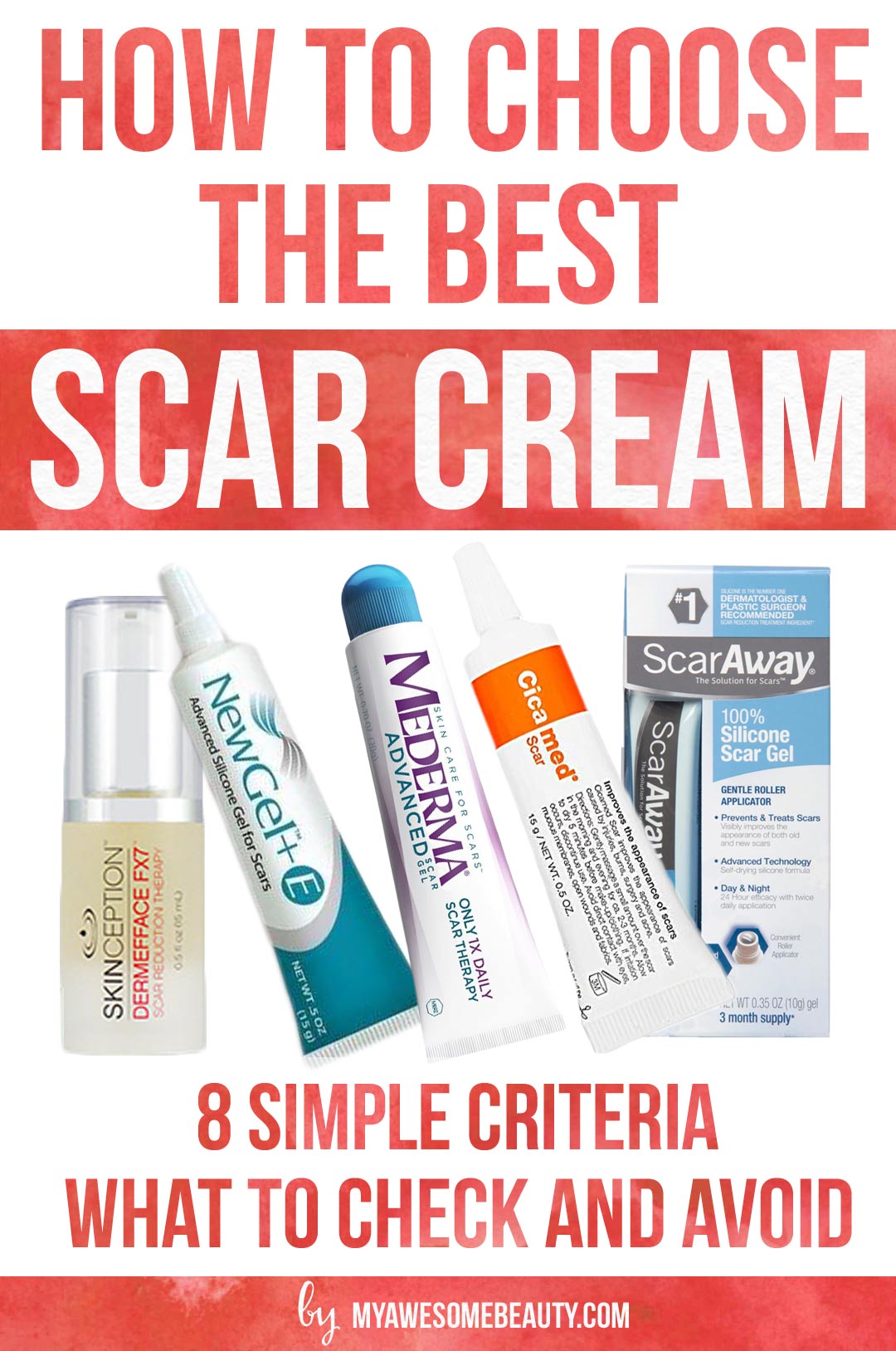
We agree with you. Scars are a real pain in the ass. They are ugly, and we all want to get rid of them. There are many scar removal treatments that can be used to fade scars.
But before resorting to more invasive treatements that are quite costly, we wanted to use first topical products that could help us make our scars less noticeable.
This is why we worked hard to find the best scar cream. It took us some time to finish those reviews but we really think we have here a simple way for you to choose what is best for your case.
What is the Best Scar Cream among the hundreds of products out there?
At myawesomebeauty.com, you know how we take our reviews seriously. We really tested many brands and products to find the best scar removal cream. We used 8 criteria (you can read about in the next sections) to assess about 50 scar removal creams.
We got our Top 3 picks and 2 scar removal creams you should avoid. As always, you don’t need to spend a lot of money to get the best one. In other words the most expensive products are not always the best ones.

- Product
- Overall Note
- Base
- Potentially Irritant
- Other actives
- Consistency
- Fragrance
- Preservatives
- Self drying time
- Quantity
- Average Price
- Verdict
The product which could have ranked 1st :
In fact, there was a product which would have taken the first spot if it was not because of the packaging. it is the SCARAWAY gel which is a great scar gel at a really good price ($10) BUT they use a new packaging with a roller applicator, which SUCKS. Th
If you want to understand how we came up with this ranking, you must first make sure you have some knowledge about the skin and how it heals. So, let’s dive in.
The Functions of the Skin

Covering around two square meters and 15% of all body weight, the skin is the largest (and one of the most important) of the body’s organs.
In case you didn’t know, it has some very important functions;
- The skin is like a shield protecting our bodies from encountering viruses, fungi, and bacteria
- Sweating allows our body to regulate temperature and prevent overheating (sweat will also eliminate products and detoxify)
- The nerves (sensory receptors) react and activate when necessary
- Lotions and light can be absorbed for vitamins and protection
Without the skin, the human body couldn’t operate because these four essential functions would be lost: protection, thermoregulation, sensation, and metabolic activity.
The 3 skin Layers to understand skin scars
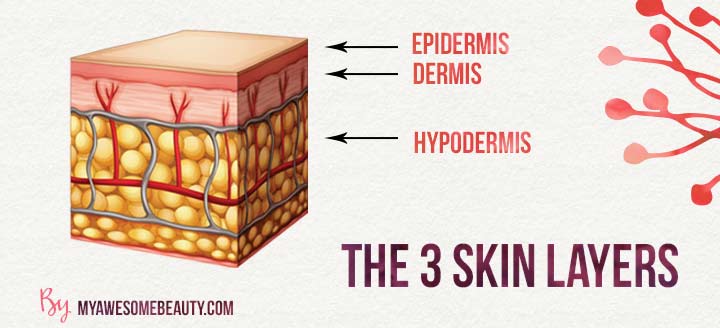
Despite popular belief, the skin is actually very complex and requires three layers in order to offer the four functions above.
Epidermis – As the outer layer, this can have a thickness of up to 1.4mm and it has two main layers of itself; stratum corneum (outer layer) and the living basal layer underneath. Over time, cells found in the basal layer will divide and the older cells are pushed towards the surface of the skin. As this occurs, the cells in the stratum corneum, now rich in keratin, are flattened (as opposed to the basal layer’s round, nucleated cells). As the cells die, they contribute to the largest part of the epidermis before the body sheds the dead skin as it reaches the very outer layer.
Dermis – Found underneath the epidermis, we have the dermis and this is a layer of support for the epidermis. Much thicker, this layer boasts elastin fibers and collagen thanks to a complex network of blood vessels. While strength is provided through the collagen, dermal elastin allows the skin its elasticity (as the name suggests!); both strength and elasticity are important features of our skin. However, it doesn’t end there because the dermis also holds hair follicles, sweat glands, and sebaceous. With this layer, the nerves it contains serve to sense and transmit pain, heat, cold, and pressure information to the brain.
Hypodermis – Finally, the hypodermis, underlying loose tissue, connects to the dermis from below. Above all else, you find in this layer the adipocytes which store fat in our body. The fat across a human’s skin generally makes up for between 15-30% of all body mass.
Why such a big variation in percentage? Men and women have very different amounts of fat tissue; women actually have more adipose tissue. (not fair!!)
How Does the Skin Scar?
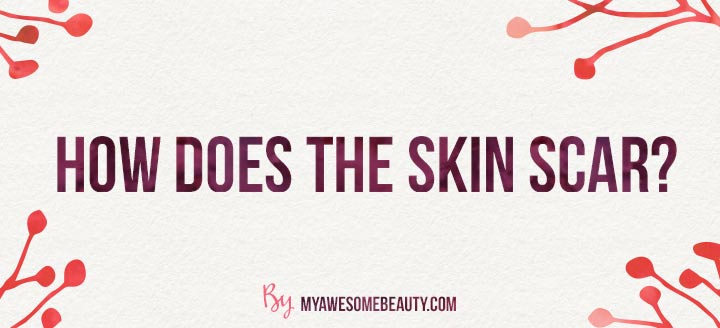
With the basics in mind, the question many people have is ‘how does skin scar?’.
As you’ll know, scarring normally comes from a prior wound as the skin attempts to repair itself (a process that begins as soon as the injury occurs).
For example, if you slice your finger with a knife while cooking, the body will produce collagen for the tissues to be reconnected. Scars contain collagen tissue (strong and flexible) from the repair process.
There are different types of scar one can experience: mature and immature.
While a mature scar develops later in the healing process, an immature scar is much earlier and, as a result, will have a red appearance, could be painful, raised, and has the potential to itch. In normal cases, the redness and swelling will disappear in a process that can take up to two years, the scar will flatten, get more pale and become a fine line but the mark will remain.
However, in some other cases, the scars left behind can be problematic, and stay raised. They can even grow and get beyond the borders of the inital wound. Common abnormal scars include keloids and hypertrophic scars which we will discuss a bit later.
The Three Stages of Scar Formation
Below, we’ve detailed the three stages of scar formation so you can see the intricacies of how it all works.
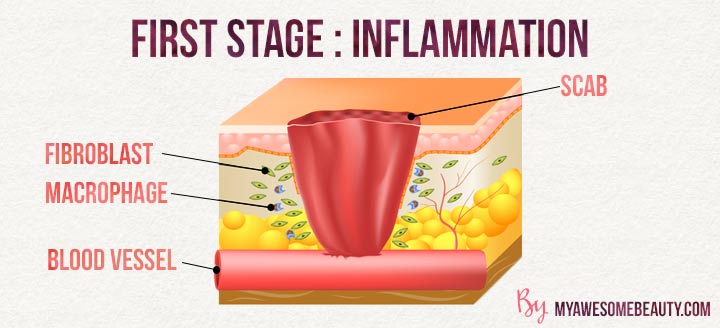
Inflammation phase – It is the first body’s response. In order to prevent extensive bleeding, the blood vessels will contract and create a clot. As the bleeding slows and then stops, the vessels dilate which allows important cells, such as white blood cells, macrophages (cells that eat the cellular particles and debris) to reach the wound.
As they attempt to repair the skin, this leads to inflammation; erythema (reddening skin), pain, heat, and edema (fluid retention) can be experienced. Within just a couple of days, a scab should form.
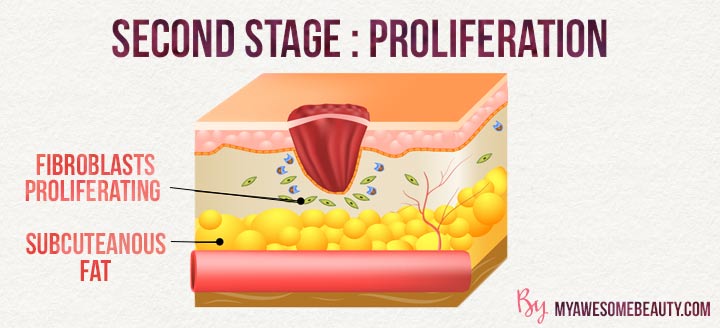
Proliferation phase – Once the inflammation phase is complete, we have the second phase. The tissue will continue the repair. For the best possible repair, the tissue needs structure and strength. This is why the fibroblasts ( skin cells) have an important role: producing tough and flexible collagen fibers that will give that structure and strength.
In order for the skin cells to receive nutrients and oxygen, new blood vessels will form in this area. If all is working as it should, the epidermis will close, the wound gets smaller, and the edges are pulled together.
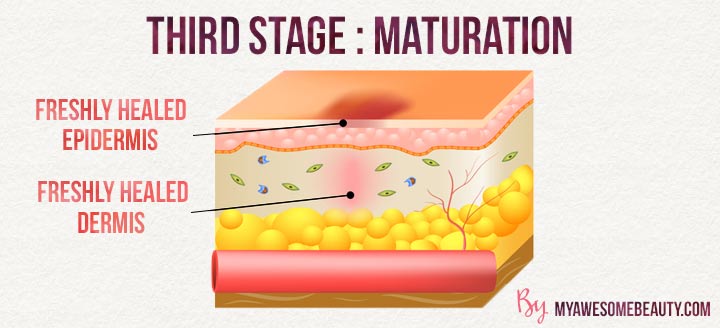
Maturation phase – After a number of weeks, the longest stage of all, called the matuartion phase, starts and, as mentioned previously, this can take anywhere up to two years to complete. As their importance dwindles, the blood vessels begin to thin while the wound continues its contraction with stronger collagen replacing any collagen produced during the previous stage. Once this final stage comes to an end, collagen scar tissue seals the wound and cell activity ceases.
So, with this information, you now realize that scars are a positive sign that the body is working as it should (despite their sometimes ‘ugly’ appearance).
Once healed, the scar tissue is the same material as the skin all over your body. But why does it look different? Because of the way this material is stitched together.
All scars have a unique appearance and this is a result of different wound depths, sizes, and location. Two scars could look different even if two people were cut in the same place and in the same way. As well as age, genetic make-up, and ethnicity, gender also plays a role.
Why is my scar raised?
One of the most common questions people with scars have is why their scar is raised when other people they know have flat scars. This comes down to the production of collagen.
The problem usually that arises with scars is that the collagen production is way too important resulting in too much collagen which leads to raised scars (hypertrophic scars) or keloid scars etc…. So, it is like everything in life, the “ugly scars “stem from a too aggressive healing process which creates too much collagen.
Think of it as if you want to print 3 pages of a document but the printer cannot stop and print 30 pages…. You end up with a large pile of sheets instead of a thin pile of only 3 paper sheets…
No wonder raised scars are mostly found among younger people ? as their healing process is more active than with older people who has a slower healing rate.
Different Types of Scars

Throughout this guide so far, we’ve mentioned a couple of scar types but what do they mean? Below, we’ve broken it all down so you can learn more about your own scar.
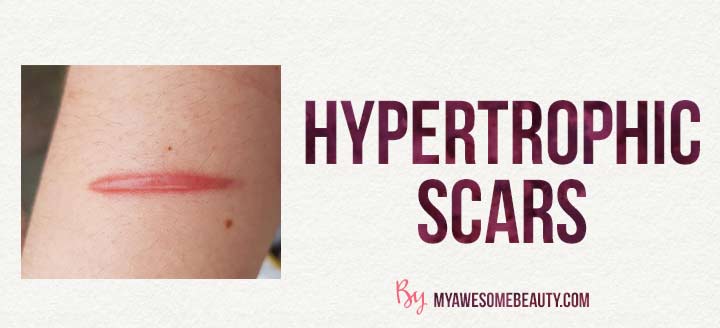
Hypertrophic Scars – These scars are generally quite red as well as being raised, but they never extend beyond the site of the injury. Essentially, the word ‘hypertrophic’ means ‘enlarged’ or “bigger than usual”
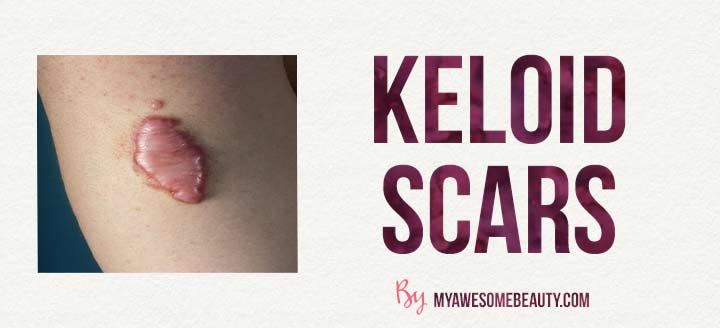
Keloid Scars – When the body overreacts in the healing process with too much collagen, this can lead to scars that extent beyond the site of the initial wound. When keloid scars form, there’s an increased risk of ‘neoplasms’ which are tumor-like welts (benign). More common in those with darker skin, keloid scars can develop after body piercings, accidents, extreme acne, and surgery.
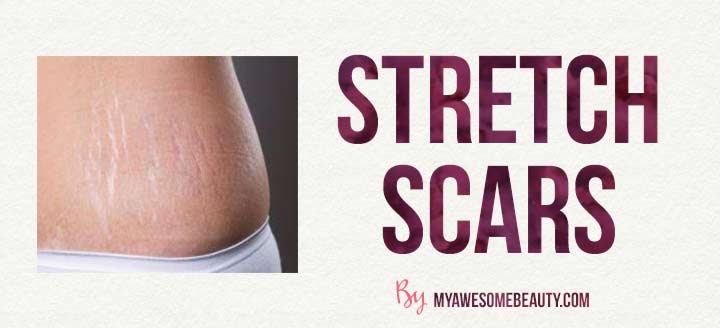
Stretch Marks – In case you were unaware, stretch marks are a type of scarring and they’re common after the skin over-stretches during extreme weight gain/loss, pregnancy, growth spurts, and even muscle gain/loss. While they can fade over the course of many years, they never really disappear completely.
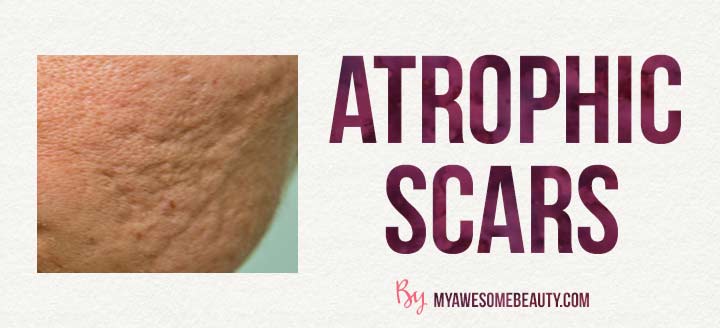
Atrophic Scars – Perhaps the most common type of scars, this appears as a divot in the skin. When fat, muscle, and other supporting structures are lost, a sunken area can develop. Common causes of these atrophic scars include acne, surgery, accidents, and chickenpox.
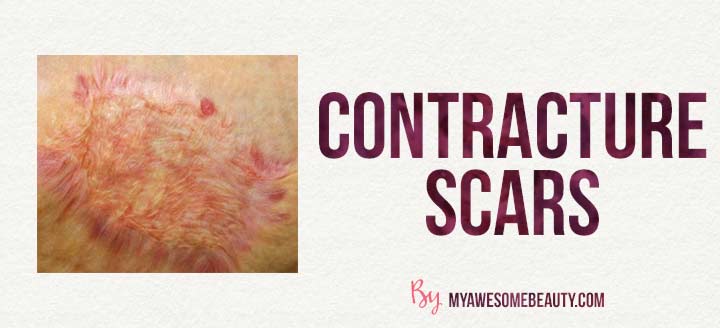
Contracture Scars – These contracture scars develop after the skin is burned; with severe damage, they can go deep into the nerves and muscles as well as the skin. As the scar tightens, this can cause numerous issues with movement.
Factors Affecting Scar Formation

So, what are the main factors that impact how a scar will eventually look?
- Age – First and foremost, age plays an essential role and it may surprise many to learn that children are at the highest risk of abnormal scarring. Because older generations have slower healing rates, their risk of abnormal scarring is reduced.
- Location – Of course, the location of the wound is also important. For example, a wound that sits in a crease or joint will be more likely to lead to an abnormal scar; breast surgery and cesarean sections are common examples.
- Genetics – After age and location, the next factor is skin type and genetics. Those with darker skin (skin types V/VI) or white, fair skin (types I/II) have a higher risk of abnormal scars. This risk then increases if there’s a history of abnormal scarring in the family or if the individual has experienced pathological scarring previously.
- Hormones – With puberty and pregnancy, the changes in hormones in the body can also make scars more prominent.
What scars can we improve with scar removal creams or gels?
As we saw in the formation process, scars can take up to two years to develop so, with this in mind, you aren’t going to find a simple solution that’ll clear the issue within a few days. If you find a cream or product offering a quick resolution, be careful because this just doesn’t exist.
However, the best way to improve a scar is to keep collagen at the right level. If possible, always go for the product that uses proven-safe ingredients.
Sadly, not every scar will benefit from such a product; for example, atrophic scars need dermatological interventions and topical treatments won’t raise the sunken area. Typically, a professional may suggest laser treatment, chemical peeling, dermabrasion, punch excisions, or radiofrequency.
On the other hand, scar creams and gels can be used with :
- hypertrophic scars,
- keloid scars,
- contracture scars (prevention)
Note that stretch marks require other specific products we will discuss on anoter article.
How To Choose the Best Scar Removal Cream : The 8 Simple Criteria
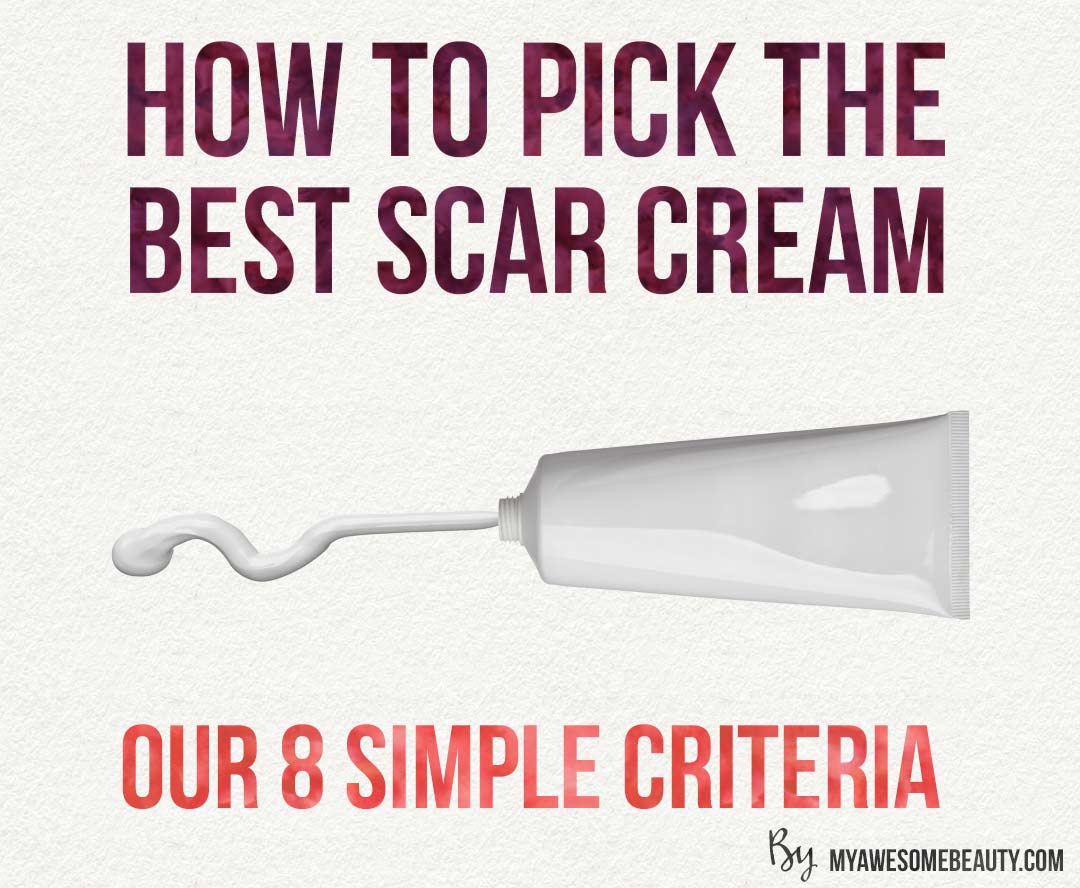
Now you have the basics of scars, how they develop, and the different types of scar, we thought we’d provide a simple guide to finding the best scar removal cream.
Before anything else, we urge you to completely ignore the marketing tricks cosmetic companies tend to try. Instead, we have eight tips for finding the perfect scar cream. Although some may go against what some brands suggest, the most important thing to consider is your OWN needs.
To assess and rank each scar removal cream, we followed 8 simple criteria.
Water-Based or Silicone – based?
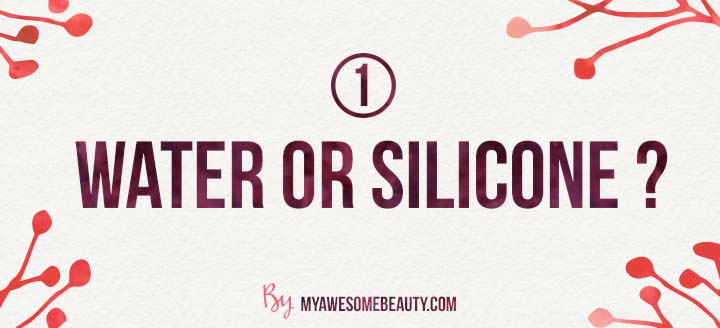
When researching the products in the market, the first difference you’re likely to see is the many water-based and silicone creams. For scar management, silicone will always be the better solution and this follows on from surgeons and scar experts recommendations and studies.
In fact, silicone products came out on top as the best treatment (and prevention) from an international multidisciplinary group containing around 24 experts.
Why is this the case?
In case you didn’t know, silicones are essentially man-made large molecules (polymers). They’re made from repeating units of siloxane which, itself, is carbon or hydrogen combined with a chain of alternating oxygen and silicon atoms. If you’ve seen the name ‘polysiloxanes’, this is why and it’s widely used in the medical world.
Why is this important for scars?
As we’ve already seen, an injury or any other trauma to the skin starts a healing process that includes scar tissue. The fibroblasts, skin cells, produce collagen which make up the scar tissue; sometimes, the produced collagen is too much for the wound and the excess creates a discolored and raised scar. While collagen plays an integral role in wound healing, the body doesn’t always produce the right amount and this is where silicone comes in handy.
Since silicone molecules sit on top of the skin (they’re too large to be absorbed), there’s no chance of it getting into the bloodstream so it doesn’t have any internal impact. As soon as the gel or cream is applied, a thin layer will stick to the site of the scar and the silicone will distribute evenly to ensure the whole area is covered. With this layer in place, no moisture from inside can escape and the healing process instantly becomes more efficient.
Called trans-epidermal water loss (TEWL), water evaporation from the skin can indeed slow healing and cause other issues.
Why is it important?
When you have a wound, the new skin is immature and is not able to properly retain moisture, so this sends a message to our body that the leak needs fixing…and this requires more collagen. As a result, more collagen is being produced and sent to the wound and it really isn’t needed.
This is where the buildup creates a raised and lumpy scar.
With a silicone layer for protection, the moisture stays underneath the surface, collagen production is at the right level, and the resulting scar should be smooth and flat.
‘But this means my skin won’t breathe!’ – While this is a common concern, it simply isn’t true because silicone is semipermeable. While not all molecules can pass through, silicone is selective to only particular molecules. Through a process called diffusion, oxygen will access the site while toxins stay away and this closed environment creates the optimum healing conditions for your wound.
All oxygen is regulated, but anything that could cause harm to the wound is kept away and this includes dirt, bacteria, and many other irritants.
Since skin isn’t a static organ, silicone isn’t just good for the prevention of scars after an injury or surgery. Over time, your skin will continually produce new skin cells to replace the old ones and this includes the scar tissue. With the right cream or gel, you can also treat older scars and keep replacing the old skin cells with newer ones.
If you still have concerns about silicone at this point, we should state that it has been extensively tested and we actually have the results of a study published in the Journal of Cutaneous and Aesthetic Surgery.
With 30 people in the study, the main goal was to test silicone gel when treating keloids and hypertrophic scars. While the patients with keloid scars experienced scars beyond the original scar boundaries, those with hypertrophic scars had to deal with reddening and raised skin.
For the patients, the study was simple because all they had to do was apply the gel twice a day. For the researchers, the results were positive and an 86% reduction in texture was seen within the first six months; the results also included a 68% reduction to the height of scars and an 84% reduction in color.
Why not water-based products?
- Water based products cannot properly seal the wound while letting it breathe as effectively even with some polymers like xanthan gum, or any cosmetic gelling agent and therefore is not as effective with scar healing as silicone-based products.
- Water-based products are also more likely to cause sensitivity reactions compared to silicone. If you have sensitive skin or you want a product for your child, silicone is the way to go.
| Product | Base | Other Amazon reviews |
|---|---|---|
| Cicamed scar treatment | Silicone | Read other reviews |
| Newgel + E | Silicone | Read other reviews |
| Mederma advanced scar gel | Water | Read other reviews |
| Dermefface Fx7 | Water | Read other reviews |
| Revitol scar cream | Water | Read other reviews |
Silicone Gels vs sheets?
Before moving on to the second consideration when buying the perfect scar cream, we should first mention the two types of silicone product you might find.
- Silicone Sheets – With various shapes and sizes available, sheets are ideal if you need to cover a large surface area. It is a good option especially if your scar is in contact with clothes as you don’t need to wait for the gel to dry. They can be cut to size and the rest saved for next time. Despite the benefits, some people have issues with the adhesiveness of the sheets on irregular skin surface and they also aren’t quite as discreet.
- Silicone Gel – Gel is generally more practical, it provides a more versatile option as it can be applied regardless of scar surface. For those with scars in visible areas, gel will blend in nicely and it also works better for areas of the body always in motion. What’s more, makeup can even be applied on top of the gel once it’s dried, which is important for us haha.
Avoid the Irritants

With anti-wrinkle creams and the like, we normally suggest a product with all the bells and whistles…but this is not the case with scar creams.
Because the newly formed skin is sensitive, vulnerable and fragile, you should be taking a close look at the ingredients on all products; you don’t want any chemicals or irritants that will impact healing.
I know it is tempting to pick a product which claims to be full of active ingredients but here it is totally useless and potentially harmful.
With any product in this niche, all you need is one that protects the wound/scar, allows oxygen in, and keeps harmful substances out.
The more it mimics natural skin, the softer and flatter the resulting scar will be.
Remember, the developing time for a scar can be two years so there are certain ingredients you should be avoiding for this period.
- Alcohol – Firstly, we want the skin to stay hydrated because this allows the skin cells to work on the wound and heal the tissue. Since alcohol does the opposite and actually dries the skin, this will make the job harder for skin cells and you’re less likely to see a smooth, flat scar.
- Acids – In this, we are including salicylic acid (BHA), glycolic acid (AHA), and many more. With even one application, acidic products can cause permanent damage. With a change in pH level, your skin will be itchy and irritable but there’s also an increased risk of hyperpigmented scars. You could also experience increased sensitivity when out in the sun.
- Synthetic Colors – Finally, another ingredient that’ll cause irritation is synthetic colors whether it’s drug and cosmetic (D&C) or food (F) coloring. When looking at the ingredients, you’ll see ‘D&C’ or ‘FD&C’ which is normally then followed by a color and number; for example, ‘FD&C Blue 1’. Regardless of the color and number, synthetic colors come from coal tar or petroleum and they can be pretty irritant to your skin so that is something you should avoid if possible while your body attempts to heal a wound.
| Product | Potentially Irritant | Other Amazon reviews |
|---|---|---|
| Cicamed scar treatment | No | Read other reviews |
| Newgel + E | No | Read other reviews |
| Mederma advanced scar gel | Yes (alcohol) | Read other reviews |
| Dermefface Fx7 | yes (acids) | Read other reviews |
| Revitol scar cream | yes (retinol) | Read other reviews |
Welcome the soothing and the hydrating
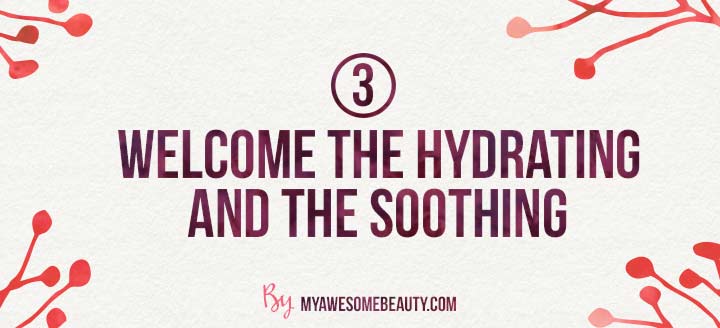
You understand now that when it comes to scar management what matters is to create a closed environment over the scar so that it can retain the moisture but still breathe. That is why silicone is absolutely the gold standard for this specific purpose.
So, when checking the ingredients, make sure silicone is in first position on the ingredient list.
The usual terms that you will find for medical grade silicone are:
- Dimethicone,
- Cyclopentasiloxane,
- Polymerized Siloxanes,
- Dimethicone/Vinyldimethicone Crosspolymer.
The silicone gels that are recommended for scar treatment are 100% or pure silicone gel.
However, some laboratories add one or two other ingredients in very small quantity (usually around than 1%) to boost the efficacy of the gels.
For certain ingredients, less is more 🙂
What are those ingredients?
- Vitamin E: It is an interesting ingredient because it has a powerful antioxidant activity. It neutralizes the harmful free radicals generated from pollution, smoke etc…What are the names on the ingredient list you will find for vitamin E? Tocopherol or Tocopheryl Acetate
- Glycerin: It is derived from plant-based oils. It is a good moisturizer that attracts water to itself and that really helps slow the evaporation of water from your skin. Be careful though, when you add too much of it, it can give a very sticky feeling and depending on the climate, it could even dry your skin. If the air has less than 65% humidity, if there is too much glycerin, it will kind of draw moisture from your skin
- Allantoin: it is a non-irritating active that soothes the skin. It is suitable for sensitive skin
Note: our personal opinion about the effect of adding those ingredients to the pure silicone gel is quite straightforward. These 3 ingredients are good, but we don’t see a huge difference when it comes to scar healing between a pure silicone gel and a silicone gel with 1% of vitamin E or glycerin, it certainly can help a little but we truly believe, this should not be the decisive factor when choosing the best scar cream or scar gel.
You will also find some brands which claim they have the best ingredients in the world. We are always doubtful when it is too good to be true and in many cases, this holds true….
Onion extract : this is the active ingredient put forward by the Mederma brand. The trouble is that the 2 studies that indicates this extract could improve scars, were funded by the mederma company itself. ( biased results? ). Moreover, a harvard study concluded that “the onion extract gel did not improve scar cosmesis or symptomatology” which is why you need to be careful when it comes to all the marketing pitches….
Some other brands claim to use many plant extracts, vitamin A, vitamin C etc…. the problem is that when formulating a product, the goal is not to stack as many ingredients as possible but to make sure we use the right ingredients.
- If you have a new scar (less than 2 years), which means the skin is still fragile, using such products are totally unsafe…. as you will irritate the skin and affect the healing process. LESS is more here.
- If you have a mature scar (over 2 years), this is another story, vitamin A (retinol) , C, plant extracts etc.. are then really good actives to use, but we would recommend you to stick with products with better percentages of actives. We don’t think Dermefface FX7 nor Revitol have really what it takes. You can find much cheaper alternatives with better percentages of actives (vitamin C serums etc..) You can check our extensive article about vitamin C serums HERE.
| Product | Other actives | Other Amazon reviews |
|---|---|---|
| Cicamed scar treatment | Vitamin E | Read other reviews |
| Newgel + E | Vitamin E | Read other reviews |
| Mederma advanced scar gel | Onion Extract, allantoin | Read other reviews |
| Dermefface Fx7 | Glycerin, plant extracts | Read other reviews |
| Revitol scar cream | Vitamin E, retinol, others (no percentages) | Read other reviews |
The Right Consistency

Next up, since you’ll be spreading the product across your skin, you need to pay attention to the consistency of the scar cream or gel.
- When a product is runny, it’s hard to apply properly and build a protective layer.
- When too thick, the layer can actually be too thick and oxygen can be prevented from getting through.
Ultimately, you’re looking for a light gel or cream that spreads across the skin for a thin layer.
The good news is that nowadays most products have similar consistency, so it should not be an issue.
Note : One brand we tested added a tiny amount of silica (probably less than 1%). let’s be clear we are not talking of the bad silica type, here the one that is used is the safe hydrated silica (silicon dioxide). We found that it helps the gel adhere better to your skin and helps the gel spread onto your skin more easily which is great as it makes the process every day easier lol. ( no, no, we are not lazy haha)
| Product | Consistency | Other Amazon reviews |
|---|---|---|
| Cicamed scar treatment | Gel | Read other reviews |
| Newgel + E | Gel | Read other reviews |
| Mederma advanced scar gel | Gel | Read other reviews |
| Dermefface Fx7 | Gel | Read other reviews |
| Revitol scar cream | Cream | Read other reviews |
The Odor Can Hurt Your Skin

When looking in a shop or online, you might be tempted to go for one with a fragrance…don’t.
Originally, this term was actually designed so a company could protect their secret formula. Today, this fact remains which means you never really know what you’re putting onto your skin.
In recent times, issues like dermatitis, allergies, and skin irritations have been linked to added ‘fragrance’ by the Environmental Working Group (EWG) Skin Deep Database.
When the skin is already fragile, the risk increases somewhat. You have a scar to heal so don’t go using a product with a fragrance which could affect the process….
Additionally, the fragrance of the cream can mix with any additional fragrances you apply and this can lead to nausea and headaches.
With an odorless scar treatment cream or gel, you can treat the scar without having to worry about potentially dangerous mixtures of chemicals.
| Product | Fragrance | Other Amazon reviews |
|---|---|---|
| Cicamed scar treatment | Free | Read other reviews |
| Newgel + E | Free | Read other reviews |
| Mederma advanced scar gel | Yes | Read other reviews |
| Dermefface Fx7 | Yes | Read other reviews |
| Revitol scar cream | Free | Read other reviews |
Avoid The Preservatives

As I told you, we want to be on the safe side when it comes to scar tissue and newly formed skin. We need to avoid any chemicals or irritants that could jeopardize the healing process and result in thick and reddened scars.
That is why you the best scar cream should not have any preservatives of all kinds in the formula.
Preservatives are quite irritant.
But there is another reason: your newly formed skin is still fragile and quite permeable meaning that it does not properly prevent some molecules from passing through. So, if you apply products with preservatives on scars, these preservatives could penetrate the skin and reach the bloodstream.
As an example, we’d like to bring to your attention ‘parabens’; these are preservatives designed to keep bacteria, yeast, and mold at bay in cosmetic products.
Unfortunately, although they do this, they also have an ability to mimic estrogen and increase the risk of breast cancer. With research showing a link between breast cancer and these dangerous chemicals, we don’t want them to have easy access to our bodies just by making the mistake of purchasing the wrong scar cream.
This preservative issue makes silicone products again the best options : since bacteria needs water to grow, and silicone isn’t a water-based product, these preservatives aren’t required.
Also, we should mention that silicone gels actually last up to three times longer than water-based products; up to six years compared to two.
| Product | Preservatives | Other Amazon reviews |
|---|---|---|
| Cicamed scar treatment | Free | Read other reviews |
| Newgel + E | Free | Read other reviews |
| Mederma advanced scar gel | Yes (Paraben) | Read other reviews |
| Dermefface Fx7 | Yes (Phenoxyethanol) | Read other reviews |
| Revitol scar cream | Yes (sodium benzoate) | Read other reviews |
The Quick Drying time

When picking your ideal scar removal cream, make sure you have a product that is fast drying.
It will be much more practical, so you won’t have to wait hours before being able to wear your clothes or simply to apply make up on top (if really you want to).
Water based products are a bit faster drying that silicone-based products. But the good news is that silicone-based gels only take about 3-4 minutes to dry which is quick enough.
Please as indicated previously, don’t use products with alcohol, which can speed up the drying process but on the other side can dry up your skin and negatively impact your scar in the long run. 3-4 minutes is really not that long so stick with silicone gels.
- With the water based gels, it will be a bit quicker.
- With creams it should be a bit in between depending on the water and oil ratio and the gelling agents.
Silicone gels will take a little more time so you will have to be a bit more patient or be a bit more organized.
Why not apply it before taking your breakfast? Then you can apply your make up afterwards and you won’t have to wait that much 😉
| Product | Self Drying time | Other Amazon reviews |
|---|---|---|
| Cicamed scar treatment | 3 mn | Read other reviews |
| Newgel + E | 3 mn | Read other reviews |
| Mederma advanced scar gel | 1 mn | Read other reviews |
| Dermefface Fx7 | 1 mn | Read other reviews |
| Revitol scar cream | 2 mn | Read other reviews |
The Price Factor

Pricing is of course one criteria you should take into account when choosing your scar cream or gel as scar treatment takes a long time. It can be as long as 2 years so you ‘d better make sure the product you picked is not too expensive
Stick to an average price of 15-30$ for a scar remover gel (higher for silicone sheets): you don’t need to pay higher prices.
Any higher priced products are not worth it as what works best here is simple stuff here. Don’t let certain brands or certain dishonest people try to rip you off….
As a side note: Everytime you check the price, remember to check the amount of product when comparing different products.
Let’s give you an example:
If you have product A ( 5g) which costs 20$ and product B (10g) which costs 25$,if you don’t check the amount of each product you could conclude that product A is cheaper but in fact if you check the ratio, product B is much cheaper than product A as for 10g of B it costs 25$ so it is 2.5$ per g and for 5 g of A it costs 20$, so it costs 4$ per g !!!
Don’t let some brands trick you. They sell less product and write the size in a tiny size so you end up being ripped off…..
| Product | Average Price | Other Amazon reviews |
|---|---|---|
| Cicamed scar treatment (15g) | $18 | Read other reviews |
| Newgel + E (15g) | $31 | Read other reviews |
| Mederma advanced scar gel ( 20g) | $15 | Read other reviews |
| Dermefface Fx7 (15g) | $50 | Read other reviews |
| Revitol scar cream (50g) | $30 | Read other reviews |
Frequently Asked Questions
To finish this complete guide about how to pick the best scar cream (gel), we want to answer some of the most common questions we encounter.
What scars can scar gel and sheets treat?
Whether you have a new wound or an older scar, silicone gel and sheets can help. These products work with hypertrophic scars, keloids, discolored scars, and anything resulting from acne, cuts, surgery, burns, etc. Previously, even people that have had certain scars for many years could notice flatter, smoother and less visible scars.
When should I start using the gel or sheets?
Once the wound has healed enough to stop crusting and oozing, it’s then ready to be treated carefully. For those who have just had surgery, we suggest waiting up to two weeks for the stitches to be removed and for your surgeon/doctor to give the green light. If it is an existing scar, there’s no reason why you can’t start immediately (assuming it has healed).
Can I use it anywhere?
Scar gels can typically be used anywhere on the body as long as you remember to avoid open wounds, mucous membranes, the eyes, and active acne lesions. If you’re unsure on anything, feel free to ask your doctor or pharmacist.
Do I need to apply every day?
Because of the benefits we have already discussed, it’s always best to have the gel on your skin as much as possible. The more consistently you apply the gel, the stronger the results should be. If you can’t manage 24 hours a day, aim for at least 12h . With silicone sheets, these can be washed and will last for up to two weeks.
How do I apply the product?
Perhaps the most common question we receive regards the application of the gel because, quite rightly, people don’t want to get it wrong. However, it only requires a thin coating of the scar after first cleaning the area. You won’t need to worry about rubbing into the scar because the silicone gel will sit on top of the skin.
If you need a little help, we recommend the following:
- Clean the area of skin and make sure it’s completely dry before going any further.
- Apply the gel with the fingertips and make sure it’s distributed evenly (the skin won’t absorb the gel).
- Let the gel dry. It normally takes around 3 minutes to dry, so if it seems to be taking much longer this probably means you applied too much; you can remove the excess with tissue. If you’ve never used scar gel before, we recommend starting with a tiny amount before building upwards.
- As soon as it is dry, you can add cosmetics, clothes, or sunscreen without any problems.
How much gel is too much?
Although general guidelines, we have provided some useful information below:
- 2-3cm linear scar – 5g should last more than 90 days
- 5-7cm linear scar – 10g should last more than 90 days
- 10-14cm linear scar – 20g should last more than 90 days
Can I combine gel treatment with moisturizer?
As mentioned in a previous question, best results will always come from if the silicone gel is in contact with your skin 24 hours/day; 7 days / week. For dermatologists, silicone gel is seen as the pinnacle of scar treatment and should ideally be used alone.
How long before I see results?
This is an open-ended question because everybody (and every scar) is unique. If you don’t see the results you expect, remember not to give up because the skin cycle lasts 28 days while scars can continue their evolution two years down the line. While you might notice softening within a week, affecting the color and thickness can take a number of weeks. Note: never compare your own scar healing process with somebody else because results will vary from one person to the next.
In the past, we’ve seen it all too frequently when people compare with their friends, feel as though they aren’t getting the results they should, and then they give up or switch product. If you aren’t patient and you don’t allow your body to heal at its own pace, you’re never going to see the results you desire. Although it can be frustrating at times, practice patience and the rewards will be all the more fulfilling.
How long will I need to use silicone gel?
Once again, there’s no ‘typical’ treatment with silicone gel and the amount of time you need to keep applying the gel depends on a number of factors. At the very least, you should be aiming to complete 60 or even 90 days. For those with existing scars they’ve had for some time, the results may take longer.
Another common mistake we see is people seeing improvement and then deciding to stop because they think the gel has done its job. Even after you see a flatter, softer scar within 60 days, we highly recommend continuing so your skin can continue to get healthier and be sure the healing is over.
Can a moisturizer be applied after the gel?
If you’ve just clicked on this page for the FAQs section, we recommend looking at how silicone gels work above. When it comes to using moisturizers after the silicone gel, it would actually be a waste because the gel has already formed a barrier for your scar; not only does this prevent certain substances from passing through, it provides moisture of its own so an additional product simply isn’t necessary.
Why do I need to protect from sun exposure?
If you’re attempting to treat a keloid scar, you’ll know that they can be darker than the skin surrounding the scar. Therefore, sitting out in the sun without protection increases the risk of tanning and making the scar even darker; this increases its visibility.
In addition to the change in appearance though, exposure to sun can also increase the production of melanin and this increases the risk of permanent hyperpigmentation. Of course, we aren’t saying that you should never enjoy the sunshine while treating your scar. Instead, just make sure scars are covered with sunscreen after the silicone gel has dried. If the scar is on your face, this becomes even more important.
Summary
There we have it, a complete guide to scars and scar removal. If you follow the advice we’ve provided today, you shouldn’t have a problem choosing the best scar cream for you, applying it correctly, and then reaping the rewards in due time.
Above all else, and although we’ve said it before, just remember that every single person on this planet is unique. While some people will see quick results with a silicone gel, others will need a little more time. Once you allow your body some time, the scar cream or gel will soon get to work and you should notice a difference in your scar.
If you have any questions, be sure to visit a medical professional who can provide advice tailored to your case. Other than that, we wish you the best and hope you can eventually be happier with your less visible scar!
In the meantime, as usual, stay awesome.
References:

